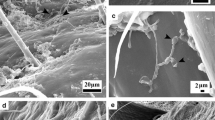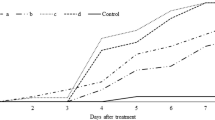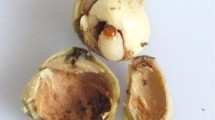Abstract
A study on 12 entomopathogenic fungi for controlling broad mite (Polyphagotarsonemus latus (Banks)) in mulberry found that Metarhizium anisopliae CKM-048 was the most virulent strain in controlling both larvae and adult broad mites at the concentration of 2 × 108 conidia/ml. There was no ovicidal effect when tested with broad mite eggs. Median lethal concentrations (LC50) of M. anisopliae in killing larvae and adults were 8.7 × 106 and 1.3 × 107 conidia/ml, respectively. Median lethal times (LT50) of larvae and adults were 2.4 and 3.8 days, respectively, at the concentration of 2 × 108 conidia/ml. The fungus was found to produce protease and chitinase. Scanning electron microscope (SEM) studies were done to monitor the infection steps of the fungus on broad mites. A greenhouse test on mulberry trees revealed that M. anisopliae could reduce the broad mite population within 4 days after treatment. However, after 7 days, its efficacy was decreased significantly.





Similar content being viewed by others
References
Abbott WS (1925) A method of computing the effectiveness of an insecticide. J Econ Entomol 18:265–267
Bonants PJM, Fitter PFL, Thijs H, den Belder E, Waalwijk C, Henfling JWDM (1995) A basic serine protease from Paecilomyces lilacianus with biological activity against Meloidogyne hapla eggs. Microbiology 141:775–784
Chatdumrong V (1996) Microbial selection for chitin digesting enzyme production. MS thesis, Kasetsart University, Bangkok (in Thai)
Chongcharoen R, Vatanyoopaisan S (2005) Study of lipase production in bacteria isolated from natural and industrial sources. Kasetsart J (Nat Sci) 39:161–166
Cuthbertson AGS, Walters KFA (2002) Pathenogenecity of the entomopathogenic fungus, Lecanicillium muscarium, against the sweet potato whitefly Bemisia tabaci under laboratory and greenhouse conditions. Mycopathologia 160:315–319
Dackman C, Chet I, Hertz BN (1989) Fungal parasitism of the cyst nematode Heterodera schachtii: infection and enzyme activity. FEMS Microbiol Ecol 62:201–208
Dawson RMC, Elliott DC, Elliott WH, Jones KM (1969) Data for biochemical research. Oxford University Press, London, 592 pp
Elad Y, Chet I, Henis Y (1982) Dedradation of plant pathogenic fungi by Trichoderma harzianum. Can J Microbiol 28:719–725
Finney DJ (1971) Probit analysis, 3rd edn. Cambridge University Press, Cambridge, 333 pp
Gerson U (1992) Biology and control of the broad mite, Polyphagotarsonemus latus (Banks) (Acari: Tarsonemidae). Exp Appl Acarol 13:163–178
Ibrahim YB, Low W (1998) Life cycle of the broad mite Polyphagotarsonemus latus (Bank) (Acari): Prostigmata; Tarsonemidae and its innate proliferating capacity on chili. Malaysian Appl Biol 27:51–56
Jeppson LR, Keifer HH, Baker EW (1975) Mite injurious to economic plants. University of California Press, Berkeley
Kemsawasd J (1976) Leaf curl disease of chili caused by the broad mite Polyphagotarsonemus latus (Banks) and its control. MS thesis, Kasetsart University, Bangkok (in Thai)
Khan A, Williums K, Molloy MP, Nevalainen H (2003) Purification and characterization of a serine protease and chitinase activity on 2D gels. Protein Expr Purif 32:210–220
Luangsa-Ard JJ, Hywel-Jones NL, Mamoch L, Samson RA (2005) On the relationships of Paecilomyces sect. Isarioidea species. Mycol Res 109(5):581–589
Lovrien RE, Gusek T, Hart B (1985) Cellulase and protease specific activities of commercially available cellulase preparations. J Appl Biochem 7:258–272
Lowry OH, Rosebourgh NJ, Farr AL, Randall RJ (1951) Protein measurement with the folin phenol reagent. J Biol Chem 193:265–275
Meikle WG, Mercadier G, Rosengaus RB, Kirk AA, Derouane F, Ouimby PC (2005) Evaluation of an entomopathogenic fungus, Paecilomyces fumosoroseus (Wize) Brown and Smith (Deuteromycota: Hyphomycetes) obtained from Formosan subterranean termites (Isop.: Rhinotermitidae). J Appl Entomol 129(6):315–322
Nugroho I, Ibrahim Y (2004) Laboratory bioassay of some entomophathogenic fungi against broad mite. Inter J Agric Biol 6(2):223–225
Palevsky E, Soroker V, Weintraub P, Mansour F, Abo-Moch F, Gerson U (2001) How species-specific is the phoretic relationship between the broad mite, Polyphagotarsonemus latus (Acari:Tarsonemidae), and its insect host? Exp Appl Acarol 25(3):217–224
Pena JE, Campbell CW (2005) Broad mite. EDIS. http://edis.ifas.ufl.edu/CHO2O, 13 September 2005.
Wagner BL, Lewis LC (2000) Colonization of Corn, Zea mays, by the Entomopathogenic Fungus Beauveria bassiana. Appl Environ Microbiol 66(8):3468–3473
Yang OH, Chen CX (1982) A study on Polyphagotarsonemus latus Banks. Kunchong Zhishi 19:24–26
Zare R, Gams W (2001) A revision of Verticillium section Prostrata IV. The genera Lecanicillium and Simlicillium gen. nov. Nova Hedwigia 73:1–50
Acknowledgements
We would like to thank the following people and institutions for their contributions: Dr. Tewin Kulpiyawat (Thai Department of Agriculture) for supporting the broad mite culture, Ms. Lawan Chatanon (TISTR) for fungal identification, and the Enzyme Technology and Waste Management Research Unit (Kasetsart Agricultural and Agro-Industrial Product Improvement Institute, KAPI) for enzyme analyses.
Author information
Authors and Affiliations
Corresponding author
Rights and permissions
About this article
Cite this article
Maketon, M., Orosz-Coghlan, P. & Sinprasert, J. Evaluation of Metarhizium anisopliae (Deuteromycota: Hyphomycetes) for control of broad mite Polyphagotarsonemus latus (Acari: Tarsonemidae) in mulberry. Exp Appl Acarol 46, 157–167 (2008). https://doi.org/10.1007/s10493-008-9153-y
Received:
Accepted:
Published:
Issue Date:
DOI: https://doi.org/10.1007/s10493-008-9153-y




